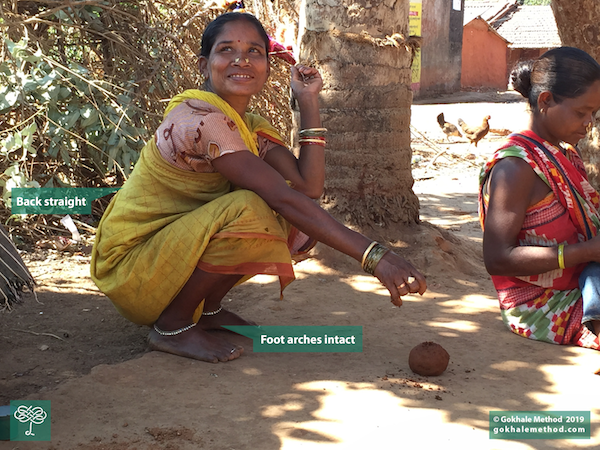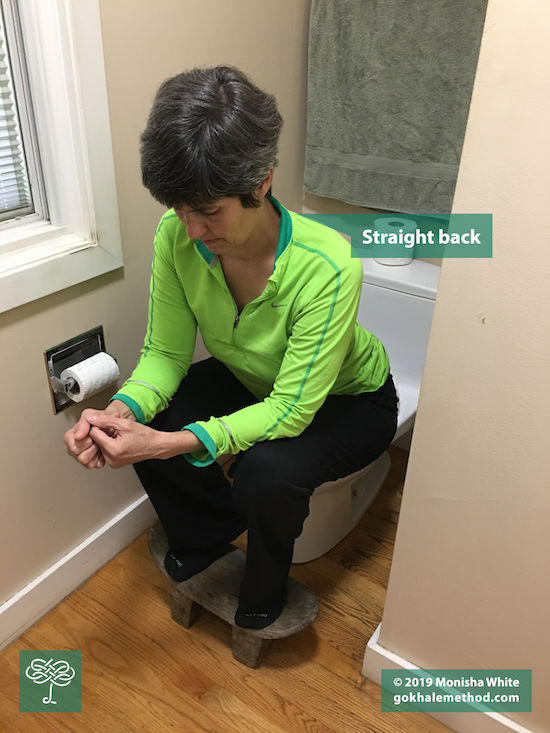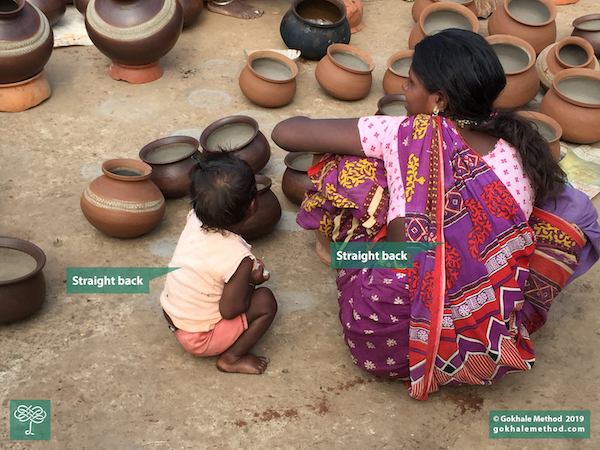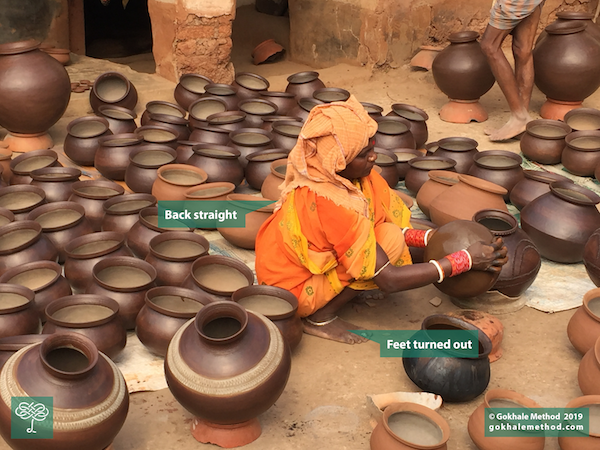How to Sit on the Floor, Part 2: Squatting
This is the second post in our multi-part series on floor sitting. For Part 1 on floor sitting, click here.
Why squat? Squatting isn’t something we do much in industrialized societies beyond childhood, but if you can do it healthfully, it is an eminently practical posture for resting the body while keeping the backside elevated off the ground and the clothing clean, as this woman from Orissa demonstrates.

This woman from Orissa demonstrates a healthy, full squat with foot arches intact and a long, straight spine.
It is also the posture used for toilet activities in places with floor toilets, a trend which has recently made its way to the industrialized realm in the form of popular footstools such as the Squatty Potty. If you have ever gone camping in a place without Port-A-Potties, you have had good occasion to squat!

Using a simple footstool to sit on a toilet, supported with a straight back.
And women worldwide, especially in less-industrialized societies, have long used squatting during childbirth. Talk about ancestral posture.

Like mother, like child.

Women squatting in a tribal market in Orissa to sell vegetables. This is a very comfortable, sustainable posture they have grown up with.
The problem
Most people’s hip, knee, and ankle joints do not bend enough to allow the back to remain straight and the arches in the feet to remain intact.

People in modern societies usually don’t have the hip/knee/ankle structure to do a full squat without rounding the back and compromising the feet.
The fix
Raise the heels or resort to a partial squat or B squat (one heel raised, the other down). Do not settle down all the way down on your haunches.

For most people, squatting with raised heels makes it possible to have a straight back.

A partial squat or B squat, with one foot on the ground (not visible) and the other foot with the heel raised. This facilitates a healthy, straight back posture.
In conclusion, for modern urban people to derive the benefits but avoid the pitfalls of squatting, consider raising your heels, or doing a “B squat” or partial squat. For going to the toilet, a Squatty Potty or low foot bench is useful. We recommend on working on your calf and quad flexibility to get low to the ground towards a squat, but do not insist on a full squat because it will likely involve some unhealthy compensations. And enjoy people watching in cultures where squatting is part of daily living. Every culture has its facilities and limitations and it’s fun that we’re all different!

This woman squats for hours to add slip onto her pots. Orissa, India.

Comments
I think the stepstool used in
I think the stepstool used in the photo above may be too short to increase the rectal canal angle enough to be of much benefit. A taller stool that raises the feet higher to a deeper squat-like posture would increase the rectal canal angle more and be of greater benefit.
Any elevation helps. How much
Any elevation helps. How much is best is very individual. There's a tradeoff between optimizing the angle of relevant canal versus taking the hip joint beyond it's possible range of motion. Leaning forward helps.
I read a useful suggestion
I read a useful suggestion from a book on “ CrossFit”. They were describing how do “squats”, as an exercise. As you have noted squatting lower than your range of motion allows, tends to cause distortions that are harmful. If you have tendency to pronate your feet excessively ( which I do), this can happen without even going very low! This is bad for feet, ankles, knees and the back. Not too mention it makes you weaker, as your bones are not aligned in a strong position. By rotating the tibia, feet and ankles outward, the bones are aligned and pronation eliminated. They said to think of screwing your (right ), foot into the ground! The left foot would “ screw”, the opposite direction. I have found this awareness enormously helpful, even while standing, walking and running. I have finally been able to eliminate excessive pronation!
This is identical to the
This is identical to the guidelines we teach and does indeed help a lot. Not sure whether holding this position in a squat for an extended period is productive, especially if the squat is for going to the bathroom or birthing a child, when you mostlywant to relax.
I agree, i guess you rr to
I agree, i guess you rr to the work of Kelly Starrett, "The supple leopard" a great guide to a healty movement, in my opinion.
I remember a video on Youtube with Kelly and Esther involved, i decided to read the Kelly's work after seeing him describing how he puts in the gym the principles of good posture, the sames of Esther's Gokhale Method.
I only was able to fix my scapulae during push ups after years of "try and error", after comprending the screwing principle, in this case applied to the arms, and keeping forearms straight.
Add New Comment
Login to add commment
Login